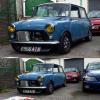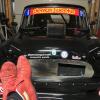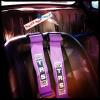im currently writing a report on turbos for uni and it is asking what it would need to convert an NA engine to Forced induction, luckly I did it last year on my own car!!
its not finished yet but im thinking this question gets asked a lot so I added what I can remember that I did on mine. :)
Converting an Engine from NA to Forced Induction
For this section it will be looking at a Mini City E with a 998cc naturally aspirated engine and what needs to be changed or modified to allow a turbo to be used on this engine reliably. Being an older engine design a lot of parts have to be added for the turbo to work correctly, below is a list of what would be needed:
- Fuel regulator
- High pressure fuel pump
- Increased diameter of fuel lines (fuel return line added, as not standard)
- Programmable ignition (Distributor as standard)
- Intercooler
- Boost gauge
- AFR gauge (Air to fuel ratio gauge)
- Dump valve
- Oil feed/drain
- Water feed/drain (if the turbo has one)
- Turbo (Garret T2 in this application)
- Sealed HIFF 44 Carburetor
- Manifolds (Exhaust and Inlet)
- Actuator
- Plenum chamber
- Colder spark plugs
- Oil pressure gauge
- Uprated oil pump
These above would be classed as modifications that would be the basics to converting from NA to Forced Induction. Without these base modifications there would be a lot of assumptions on how to car is performing.
The Fuel regulator is in the system to regulate the PSI of the fuel coming into the carb, this would work together with the carb plenum to create a raising PSI fuel rate, this is done by connecting the plenum and the fuel regulator together with a pipe, the fuel regulator then senses the rise in boost pressure and makes sure the PSI is always at the correct amount, idle PSI is set at around 1-3psi and the regulator raises this with boost, this is an important feature as lean off would mean big trouble for a turbo engine.
High pressure fuel pump is there to maintain the correct amount of fuel gets to the fuel regulator.
Increased diameter fuel lines are added for the same reason, if the pipe is too small it won’t allow enough fuel to get to the regulator, also the return line must be as unrestrictive as possible to allow the fuel to flow back to the tank, this must be plumbed before the pump on the low pressure side otherwise fuel would be sent up both pipes causing a lot of trouble.
Programmable ignition is a big feature to be added, with is car it originally ran with a distributor, now this is removed something needs to replace it, the ECU takes over this to allow for greater tunabity and safety by knowing exactly where the engine is at all times. To allow this system to work it must know where the engine is to start, this is done by fitting a crank position sensor which measures the rotation of the crank allowing the ECU to know the exact RPM, next would be the MAP (Manifold Absolute Pressure) sensor in this application this allows the ECU to know the load being put on the engine. These are the inputs for the ECU this is all it needs to make the engine run, next are the outputs which in this case is only to the coil pack which gives the engine its firing order.
The intercooler has been mentioned already in this report and its advantages stated and that’s why it is used.
A Boost Gauge is important to know what boost pressures are being ran, this is more of a safety feature.
AFR Gauge, this is a very important piece of equipment, it is used to measure how rich or lean the mixture is in the exhaust, as a turbo engine can be damaged quickly with a lean out it is nice to see if the mixture is correct, you can also catch any problems before they get to bad. This is another safety feature.
Dump valves are used to try and minimise the pressure fluctuations and surges that happen through the system, as the turbo would like to keep spinning via inertia after the engine has decelerated, this would cause a pressure spike the dump valve is here to release that from the system.
Oil feed/drain, the feed is needed to cool the turbo but more importantly to keep the turbo lubricated without this the turbo wouldn’t last very long at all. The oil drain is just as important to get correct, if the oil drain is too restrictive it can cause the oil to pool in the turbo damaging seals and forcing oil into the fuel mixture causing it to go lean, WHICH IS BAD.
Water feed/drain if the turbo has these they must be plumbed in otherwise the turbos life will be reduced.
Sealed HIFF 44 Carburetor, this is the type of carb that will work with a mini engine, it’s a sealed unit which allows pressurized air to work with it.
Manifolds (Exhaust and Inlet), these would both need to be changed to allow for use of the turbo.
Actuator is fitted to maintain the chosen amount of boost, it works by sensing the boost pressure and opening the wastegate to keep it at the correct amount.
Plenum chamber, the function of the plenum is to equalize pressure for more even distribution, because of irregular supply or demand.
Colder spark plugs must be used as the charge is being cooled down more than the standard system.
An Oil pressure gauge is a must as any drop off in
Supporting Modifications
- Large bore exhaust system
- X pin diff
- Radiator
- Brakes
Engine mounts
Edited by coopdog, 25 January 2016 - 03:59 PM.















